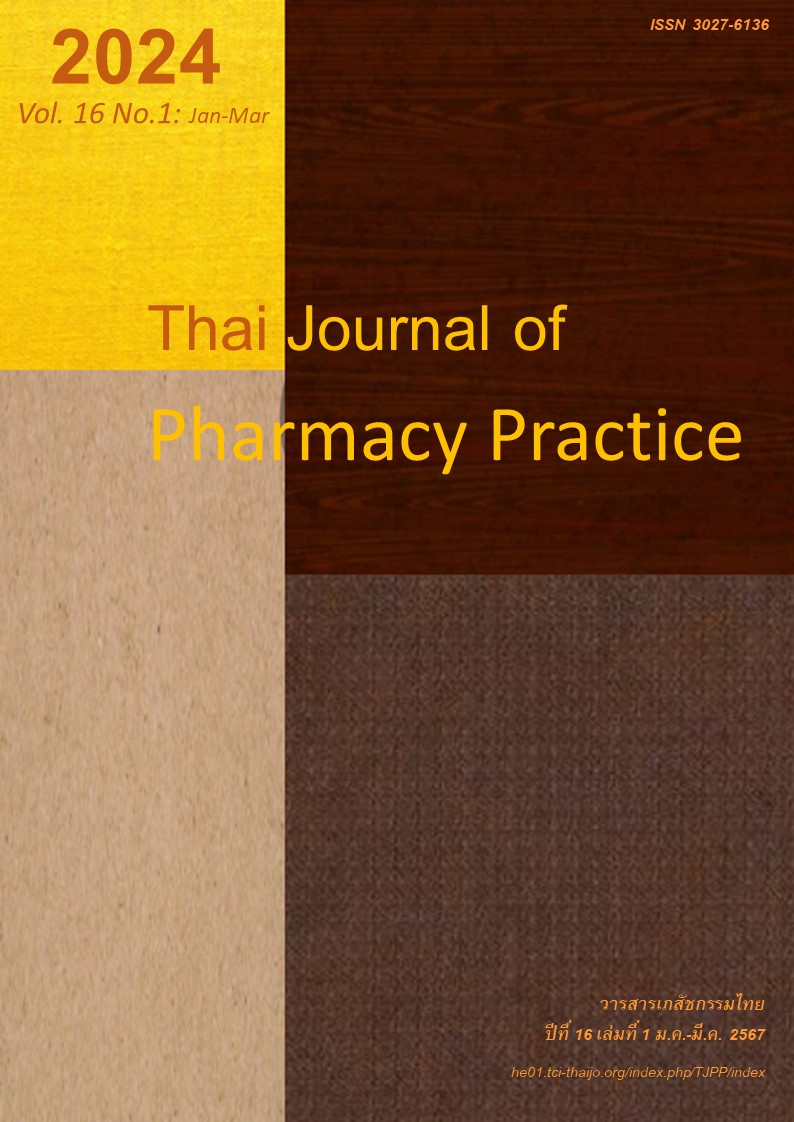การพัฒนาแบบประเมินสมรรถนะการใช้ยาอย่างสมเหตุผลของตนเองสำหรับเจ้าพนักงานเภสัชกรรม
Main Article Content
บทคัดย่อ
วัตถุประสงค์: เพื่อพัฒนาและตรวจสอบคุณภาพของแบบประเมินสมรรถนะตนเองในการใช้ยาอย่างสมเหตุผลสำหรับเจ้าพนักงานเภสัชกรรม วิธีการ: การวิจัยนี้เป็นการพัฒนาเครื่องมือประกอบด้วย 2 ขั้น คือ ขั้นที่ 1 การศึกษากรอบสมรรถนะด้านการใช้ยาอย่างสมเหตุผลและสมรรถนะของเจ้าพนักงานเภสัชกรรมที่เกี่ยวข้องกับการใช้ยาอย่างสมเหตุผล และขั้นที่ 2 การพัฒนาและตรวจสอบคุณภาพเครื่องมือ การศึกษาความตรงเชิงโครงสร้างของแบบวัดใช้การวิเคราะห์องค์ประกอบเชิงสำรวจ การสกัดองค์ประกอบใช้เทคนิคการวิเคราะห์องค์ประกอบหลัก และหมุนแกนองค์ประกอบแบบตั้งฉากด้วยวิธี varimax การวิเคราะห์ความตรงเชิงจำแนกทำโดยการเปรียบเทียบคะแนนจากแบบวัดระหว่างผู้ที่ปฏิบัติงานด้านคลินิกกับผู้ที่ทำงานด้านอื่น ผลการวิจัย: ผู้ตอบแบบสอบถาม 193 คนเป็นเจ้าพนักงานเภสัชกรรมที่ปฏิบัติงานในแผนกคลินิกร้อยละ 79.30 และปฏิบัติงานในแผนกอื่น ๆ ร้อยละ 20.70 ภายหลังการสกัดองค์ประกอบจากตัวแปรสังเกตได้เริ่มแรก 36 ตัว คงเหลือตัวแปร 36 ตัว ใน 4 องค์ประกอบ ค่าน้ำหนักองค์ประกอบของตัวแปรอยู่ที่ 0.54 – 0.87 ค่าไอเกนอยู่ระหว่าง 4.301 – 7.741 องค์ประกอบทั้ง 4 มิติ ได้แก่ 1) เจตคติในการใช้ยาอย่างสมเหตุผล 2) ความรู้ในการใช้ยาอย่างสมเหตุผล 3) ทักษะในการใช้ยาอย่างสมเหตุผล และ 4) การจัดและจ่ายยาเพื่อการใช้ยาอย่างสมเหตุผล โดยสามารถอธิบายความแปรปรวนได้ร้อยละ 21.50, 19.53, 14.87 และ 11.95 ตามลำดับ ทุกองค์ประกอบสามารถร่วมกันอธิบายถึงความแปรปรวนของแบบประเมินได้ถึงร้อยละ 67.85 ทั้งนี้ ภายหลังการจัดกลุ่มตัวแปรตามองค์ประกอบ เครื่องมือนี้ยังคงมีความเที่ยงในระดับสูง โดยค่าสัมประสิทธิ์แอลฟาของครอนบาคทั้งฉบับเท่ากับ 0.96 นอกจากนี้ยังพบว่า โดยรวมแบบประเมินนี้สามารถจำแนกกลุ่มตัวอย่างที่ปฏิบัติงานในแผนกคลินิกกับแผนกอื่น ๆ ออกจากกันได้ สรุป: แบบประเมินสมรรถนะตนเองในการใช้ยาอย่างสมเหตุผลสำหรับเจ้าพนักงานเภสัชกรรมฉบับนี้ เป็นเครื่องมือประเมินฉบับแรกของประเทศไทยที่ได้รับการพัฒนาและมีความตรงเชิงโครงสร้างและมีความเที่ยงในระดับสูง
Article Details

อนุญาตภายใต้เงื่อนไข Creative Commons Attribution-NonCommercial-NoDerivatives 4.0 International License.
ผลการวิจัยและความคิดเห็นที่ปรากฏในบทความถือเป็นความคิดเห็นและอยู่ในความรับผิดชอบของผู้นิพนธ์ มิใช่ความเห็นหรือความรับผิดชอบของกองบรรณาธิการ หรือคณะเภสัชศาสตร์ มหาวิทยาลัยสงขลานครินทร์ ทั้งนี้ไม่รวมความผิดพลาดอันเกิดจากการพิมพ์ บทความที่ได้รับการเผยแพร่โดยวารสารเภสัชกรรมไทยถือเป็นสิทธิ์ของวารสารฯ
เอกสารอ้างอิง
World Health Organization. Promoting rational use of medicines: core components. Geneva: World Health Organization, 2002.
National Drug Information. Rationale drug use situa- tion, Problem conditions and related factors 2016 [online]. 2016 [cite Jul 21, 2021]. Available from: ndi.fda.moph.go.th/uploads/policy_file/20170801152053.pdf.
Lekhakula A, Aiewruengsurat D, Sangthawan P. Good prescribing for RDU country. Bangkok: Saha mit Pattana (1992); 2021.
Food and Drug Administration Thailand. National drug policy, A.D. 2O11 and national drug system development strategy A.D. 2012-2016. Nonthaburi: Agricultural Co-operative Federation of Thailand; 2011.
Rational Use of Drug Subcommittee. Teacher’s guide for promoting rational drug use. Nonthaburi: Food and Drug Administration, Ministry of Public Health; 2017.
Praboromarajchanok Institute. Diploma programme in pharmaceutical techniques, revised in 2018. Nonthaburi: Praboromarajchanok Institute; 2018
Koehler T, Brown A. A global picture of pharmacy technician and other pharmacy support workforce cadres. Res Social Adm Pharm 2017; 13: 271-9.
Mattingly AN, Mattingly II TJ. Advancing the role of the pharmacy technician: A systematic review. J Am Pharm Assoc 2018; 58: 94-108.
Desselle SP, Hoh R, Holmes ER, Gill A, Zamora L. Pharmacy technician self-efficacies: Insight to aid future education, staff development, and workforce planning. Res Social Adm Pharm 2018; 14: 581-8.
Subcommittee on the Promotion of Rational Drug Use. Rational drug use hospital manual. Bangkok, Publishing House of Agricultural Cooperative Federa tion of Thailand; 2015.
Udomsuk L, Khumsikiew J, Supapaan T, Phanpa nich W, Prakrankamanant P. The self-evaluation of knowledge, skills, and attitudes toward rational drug use among medical students and postgraduates. Isan Journal of Pharmaceutical Sciences 2020; 16: 15-27.
Charoensuk S, Leungratanamart L, Reunreang T, Turner K, Theinpichet S. An evaluation of competen- cy in rational drug use of nursing graduates. Journal of the Royal Thai Army Nurses 2020; 21: 158-68.
Phaengwong P, Naewbood S, Oba N. Factors related to rational drug usage competency of nurse practitioners in primary care system, Nakhonsawan province. Humanities and Social Science Research Promotion Network Journal 2020; 3: 56-67.
Samranbua A, Thamcharoentrakul B. Factors predicting rational drug use among nursing students in Boromarajonani College of Nursing, Nakhon Ratchasima. Journal of Health and Nursing Education 2020; 26: 37-53.
Putthikhan P, Suwannapong K, Angsirisak N, Turner K, Theinpichet S. An evaluation of the policy of integrating RDU curriculum into the bachelor of nursing science program and RDU competency of nurse instructors. Thai Red Cross Nursing Journal 2020; 13: 282-302.
Strategy and Planning Division: GIS health [online]. 2021 [cite Jul 21,2021]. Available from: gisheal th.moph.go.th/healthmap/index.php
Gorsuch RL. Factor analysis. 2nd ed. Hillsdale, NJ: Erlbaum; 1983.
Davis LL. Instrument review: Getting the most from your panel of experts. Appl Nurs Res 1992; 5: 194–7.
Grant JS, Davis LT. Selection and use of content experts in instrument development. Res Nurs Health 1997; 20: 269–74.
Polit DF, Beck CT. Nursing research: Principles and methods. 7th ed. Philadelphia: Lippincott, Williams, & Wilkins; 2004.
Waltz CF, Strickland OL, Lenz ER. Measurement in nursing and health research. 3rd ed. New York: Springer; 2005.
Srisatidnarakul B. Development and validation of research instruments: psychometric properties. Bang kok: Chulalongkorn University Printing House; 2012.
DeVellis RF. Scale development: theory and applications. California: Sage; 2010.
Royal Pharmaceutical Society. A competency frame work for all prescribers, Prescribing competency framework. [online]. 2016 [cite Jul 14,2021]. Available from: www.rpharms.com/Portals/0/RPS% 20document%20library/Open%20access/Profession al%20standards/Prescribing%20competency%20framework/prescribing-competency-framework.pdf.
The Pharmacy Council of Thailand. Competencies of pharmacy technician from the resolution of the Pharmacy Council meeting no. 6/2014. Nonthaburi: Ministry of Public Health; 2014.
Aungsuchoti S, Wijitwanna S, Pinyopanuwat R. Statistics for social science and behavioral science research: Techniques for using Lisrel program. 3rd ed. Bangkok: CDMK printing; 2009.
Kriyawan Y. Multivariate statistical analysis for re- search. Bangkok: Chulalongkorn University Printing House; 2013.
Vanichbuncha K. Advanced statistical analysis with SPSS for Windows. 12th ed. Bangkok: Chulalong korn University Printing House; 2017.
Khumsikiew J, Sripa S, Moolsarn S, Anderson C, Supapaan T. Development and exploratory factor analysis of the tool for evaluating the opinion of multidisciplinary on “the service plan: rational drug use” based on the CIPP model. Thai Journal of Pharmaceutical Practice 2022; 14: 632-49.
Hair JF, Black WC, Babin BJ, Anderson RE. Multivariate data analysis. 7th ed. Harlow, United Kingdom: Pearson Education; 2014.
Lynn MR. Determination and quantification of content validity. Nurs Res 1986; 35: 382–5.
Tang W, Cui Y, Babenko O. Internal consistency:do we really know what it is and how to access it?. J Psychol Behav Sci 2014; 2: 205-20.
Weir JP. Quantifying test-retest reliability using the intraclass correlation coefficient and the SEM. J Strength Cond Res 2005; 19: 231-40.
Nunnally JC, Bernstein IH. Psychometric theory. 3rd ed. New York: McGraw Hill, Inc.; 1994.
Praboromarajchanok Institute. Handbook of opera tions for the formation of graduate identity Praboro-majchanok Institute. Nonthaburi: Yuttarin Printing; 2011.
Praboromarajchanok Institute. Handbook of internal educational quality assurance. According to vocation al standards of 2018, colleges under Praboroma rajchanok Institute. Nonthaburi: Praboromarajchanok Institute; 2018.
Laolapha P. Information literacy: learning skills for 21st century. Bangkok: Chulalongkorn University Printing House; 2020.
McClelland DC. Testing for competence rather than intelligence. Am Psychol 1973; 28: 1-14.
Office of the Civil Service Commission. Civil service competency determination guide: Core competency guide. Nonthaburi: Prachoomchang; 2010.


